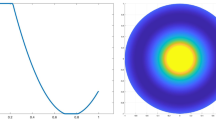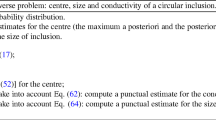Abstract
We explore an optimal design problem in two-dimensional conductivity for a rather general cost depending on the underlying field. Through a typical variational reformulation that has been explored recently, we provide a simplified relaxed version which is amenable to numerical simulation, and prove that it is a true relaxation under a main structural hypothesis. Several important cases are covered including a linear cost in the gradient and a convex, isotropic functional (in particular, the pth power of the field for any \(p\geqq1\)). For the isotropic, non-quadratic case, our computations do not require an explicit form of the constrained quasiconvexification of the equivalent vector variational problem. That structural assumption ties together the underlying state equation and the integral cost.
Similar content being viewed by others
References
Allaire G. (2002) Shape Optimization by the Homogenization Method. Springer-Verlag, Berlin
Aranda, E., Pedregal, P. Constrained envelope for a general class of design problems. Discrete Contin. Dyn. Syst., Supplement July 2003, 30–41 (2002)
Ball, J.M. Some open problems in elasticity. Geometry, Mechanics and Dynamics (eds. P. Newton, P. Holmes, A. Weinstein), Springer, New York, pp 3–59, 2002
Battacharya K., Dolzmann G. (2001) Relaxation of some multi-well problems. Proc. Roy. Soc. Edinburgn Sect. A 131, 279–320
Bellido J.C., Pedregal P. (2002) Explicit quasiconvexification of some cost functionals depending on derivatives of the state in optimal design. Discrete Contin. Dyn. Syst. 8, 967–982
Bousselsal M., Le Dret R. (2002) Remarks on the quasiconvex envelope of some functions depending on quadratic forms. Boll. Unione. Mat. Ital. Sez. B Artic. Ric. Mat. 5, 469–486
Bousselsal M., Le Dret R. (2002) Relaxation of functionals involving homogeneous functions and invariance of envelopes. Chinese Ann. Math. Ser. B 23, 37–52
Cherkaev A. (2002) Variational Methods for Structural Optimization. Springer-Verlag, New York
Donoso, A., Pedregal, P. Optimal design of 2-D conducting graded materials by minimizing quadratic functionals in the field. Structural Opt., in press
Grabovsky Y. (2001) Optimal design problems for two-phase conducting composites with weakly discontinuous objective functionals. Advan. in Appl. Math. 27, 683–704
Lipton R. (2004) Stress constrained G closure and relaxation of structural design problems. Quart. Appl. Math. 62, 295–321
Lipton R. (2004) Bounds on the distribution of extreme values for the stress in composite materials. J. Mech. Phys. Solids 52, 1053–1069
Lipton R. (2003) Assessment of the local stress state through macroscopic variables. Philos. Trans. R. Soc. Lond. Ser. A Math. Phys. Eng. Sci. 361, 921–946
Lipton R. (2002) Relaxation through homogenization for optimal design problems with gradient constraints. J. Optim. Theory Appl. 114, 27–53
Lipton R. (2002) Design of functionally graded composite structures in the presence of stress constraints. Internat. J. Solids Structures 39, 2575–2586
Lipton, R., Velo, A. Optimal design of gradient fields with applications to electrostatics. Nonlinear Partial Differential Equations and Their Applications, Collège de France Seminar, Vol XIV (Paris, 1997/1998), 509–532, Studies in Mathematics and its Applications, 31, North Holland, Amsterdam, 2002
Murat, F. Contre-exemples pur divers probèmes ou le contrôe intervient dans les coefficients. Ann. Mat. Pura Appl. (4) 112, 49–68 (1977)
Pedregal P. (2000) Optimal design and constrained quasiconvexity. SIAM J. Math. Anal. 32, 854–869
Pedregal P. (2000) Variational Methods in Nonlinear Elasticity. SIAM, Philadelphia
Pedregal P. (2004) Constrained quasiconvexification of the square of the gradient of the state in optimal design. Quart. Appl. Math. 62, 459–470
Tartar, L. Remarks on optimal design problems. Calculus of Variations, Homogenization and Continuum Mechanics (G. Buttazzo, G. Bouchitte and P. Suquet, eds). World Scientific, Singapore, 279–296, 1994
Tartar, L. An Introduction to the Homogenization Method in Optimal design. Springer Lecture Notes in Mathematics, Vol. 1740, 47–15610, 2000
Author information
Authors and Affiliations
Corresponding author
Additional information
Communicated by M. Ortiz
Rights and permissions
About this article
Cite this article
Pedregal, P. Optimal Design in Two-Dimensional Conductivity for a General Cost Depending on the Field. Arch Rational Mech Anal 182, 367–385 (2006). https://doi.org/10.1007/s00205-006-0007-7
Received:
Accepted:
Published:
Issue Date:
DOI: https://doi.org/10.1007/s00205-006-0007-7




